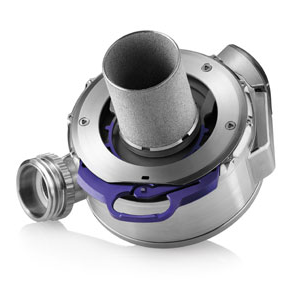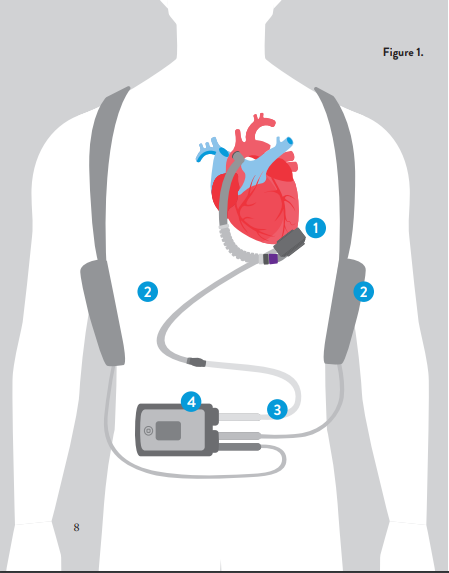Left Ventricular Assist Device (LVAD)
The left ventricular assist device, LVAD for short, is a medical device that helps to pump blood into the body from the left ventricle of the heart. It is implanted into the heart through your chest during a surgical procedure. A drive line connects the internally implanted pump (LVAD) to an external controller and power source.

LVAD treatment is for patients who have been diagnosed with advanced heart failure, a condition in which the heart cannot pump enough blood to meet the body’s needs. Click here to learn about heart failure.
Patients who have advanced heart failure have debilitating symptoms. They often have multiple hospital visits each year, experience lower blood pressure and defibrillator discharges. They may also have a poor appetite, weight changes and fatigue and find themselves unable to take heart medication because of dizziness. These patients have a poor prognosis, in some cases between 45 and 75 percent one-year mortality without advanced therapy. Thus, the mortality rate can be worse than some cancers.
LVAD it is used for patients who need short- or long-term mechanical circulatory support and for whom transplant is not an option. This technology is not suitable for all patients with end-stage heart failure, for example, those who have infections or conditions like liver disease, lung disease, kidney failure, allergies to anticoagulation products, as well as other complicating factors.
The LVAD can be implanted in some patients who are diagnosed with end stage heart failure. It pumps blood out of the heart to the rest of the body. The device is implanted directly into your heart through a surgical procedure and connected to an external controller and power source. The controller powers the pump and checks to see how the LVAD is functioning. The controller is connected to a power supply (powered by rechargeable batteries or a mobile power unit plugged into an electrical socket).

The Heartmate 3™ LVAD is implanted by a trained cardiac surgeon. There are components placed inside and outside the body to help your heart:
- HeartMate LVAD pump*
Connected to the left side of the heart and moves blood from the heart to the rest of the body.
-
Batteries
Provide up to 17 hours of uninterrupted power.
-
Driveline
Transfers power and information between the controller and the heart pump. This component is partially outside of the body.
-
Controller
Powers and checks the pump and driveline. This easy-to-wear controller weighs less than one pound and discreetly slips into a front pocket. The controller uses alerts to to tell you how the system is working and includes 15 minutes of emergency backup power.
The device Willis Knighton offers is the Heartmate 3™ LVAD made by Abbott. The Heartmate 3 was approved by the FDA in 2017 and is the latest innovation in LVAD therapy. It can enhance a patient’s quality of life and survival rate. Most patients are able to take part in activities that were not possible before the implant.
The HeartMate 3 offers:
- The highest survival rate for any LVAD in a randomized controlled trial.
- Immediate, significant and sustained improvements in functional capacity and quality of life.
- Numerous studies have been conducted regarding this technology, and one has showed greater than 85% chance of survival at two years.
If you and your doctor agree that an LVAD is right for you, you will undergo an extensive evaluation, including blood work, radiology imaging, echocardiogram, cardiopulmonary stress test, and heart catheterization. Prior to the procedure you will meet with members of the LVAD team:
- Heart failure cardiologist - Doctor specialized in treating advanced heart disease.
- Cardiothoracic surgeon - Surgeon with specialized training in surgery on who have poor heart function
- LVAD coordinators - Staff who will help plan your care and answer all questions throughout your LVAD journey
- Social worker - Person who will help the team learn about your support system and who will address any concerns you may have. The social worker will meet with you and your family to help provide support and resources to help with your recovery.
- Palliative care specialist – Person to help guide you and your family as you deal with your advanced heart disease. This specialist can help with planning your future care, decision making, and offer emotional support to help you make personal goals related to your care.
- Cardiac Rehab and physical therapy specialists – Specially-trained staff who will help you regain your strength after surgery and support your activity levels.
![LVAD Team with Feagin] LVAD Team](/images/default-source/service-lines/heart-and-vascular-institute/teams/lvad-team-with-feagin-6a34ae02-e96a-4e9e-9dac-037aed4733c1.jpg)
These are the usual steps during the procedure, which can last from four to six hours.
- You receive medications from an anesthesiologist to put you to sleep.
- You will be connected to a ventilator to help you breathe during the procedure.
- The surgeon makes a cut in your chest to access your heart.
- You will be connected to a machine to help pump blood during the surgery.
- The surgeon places the LVAD in the Left ventricle (lower left chamber of your heart) and connects to your aorta (main artery that carries blood from your heart to your body)
- When the LVAD is implanted and connected, the surgeon will disconnect you from the blood pumping machine and blood will pump through your heart and new LVAD.
- From surgery you are sent to a specialized cardiovascular intensive care unit (ICU) to recover. You will be connected to monitors to check your heart and body and to a ventilator until you can breathe on your own.
- After the ICU stay, you will be moved to a different room in a specialized cardiac stepdown unit where your doctor and staff can monitor you and help you learn to function with the LVAD.
- When are ready to be discharged, your team will be sure you have complete instructions and understand LVAD care as well as care of the surgical site. They are happy to answer any additional questions at this time.
The average stay in the hospital is two to three weeks, but this can vary based on each patient’s individual needs.
An LVAD coordinator will develop a detailed plan to teach you about the device. Both you are your caregiver will receive daily education about how the device works, how to care for your LVAD, dressing changes, precautions and what to do in an emergency. You will also be educated on guidelines for your daily activities, medications, and diet. After receiving all of this information, you will have to demonstrate that you can care for yourself before we will allow you to go home. So, once you are at home, we feel you will be confident to move forward with your life and your LVAD. We will also give you a number where you can reach a member LVAD team 24/7.
There are risks associated with every surgery. Your LVAD team will discuss the risks with you prior to your surgery and tell you about what we do to reduce them.
Some of the most common risks are:
- Infection
- Bleeding
- Blood clots
- Stroke
- Right sided heart failure
- LVAD malfunction
To minimize these risks, you will be closely monitored after your LVAD is implanted and special precautions will be taken to support the success of your LVAD.
Anyone with congestive heart failure must make healthy lifestyle choice, before, during and after the LVAD procedure. These include:
- No smoking.
- No drinking of alcohol
- No use of illegal drugs
- A low salt, healthy diet as recommended by your healthcare team.
- Regular exercise
- Commitment to cardiac rehab. You will have some limitations, such as contact sports, swimming and weight lifting.
LVAD Referral
If you believe you may qualify for a LVAD or if you are a referring physician, call (318) 631-6400 to set up and appointment for an evaluation or click the link below to request a call.
Request a Call